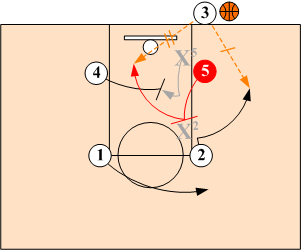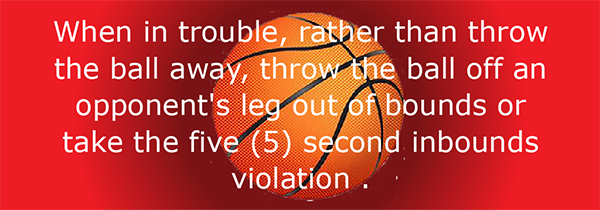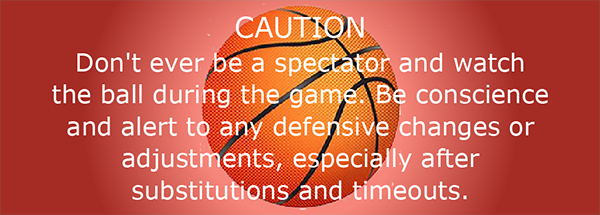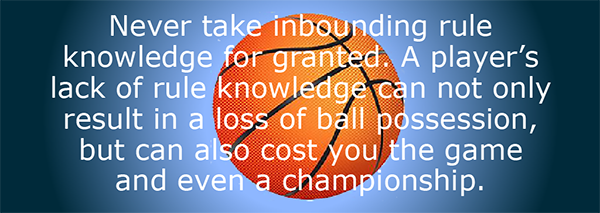- Offensive Techniques & Strategies
Out of Bounds Situations
What to Discover or Recall . . .
Out of bounds situations play a major part of the game.
Do not take inbounding the ball for granted.
Teams must be prepared to successfully inbound the ball from the baseline, sideline and full court.
Players must know the out of bounds rules.
| Guidelines | Rules | Baseline Out of Bounds | Sideline Out of Bounds | Full Court Out of Bounds | End of Game |
Out of Bounds Guidelines
Some coaches just like to get ball inbounds and then set up a play, while other coaches find it a great opportunity to attack; and, since most teams are poorly prepared to defend out of bounds situations, they deploy several inbounds plays during a game. However, no matter what philosophy is utilized, the primary objective is to first inbound the ball successfully, and then get into the hands of your best players for a high percentage shot.
During a game, do not expect players to execute something that has not been practiced. Drawing up a new "hope" play during a time out is rarely successful since most players cannot read play diagrams, let alone execute them. When creating out of bounds plays, keep them simple. Go to your best player, then height and best shooter third.
Inbounding the Ball

Players on all levels need to be taught and practice the fundamental skills and concepts needed in making a successful inbounds pass. In additional to the physical skills involved, since inbounders are taken for granted and very rarely rewarded for the efforts, they must also have a strong commitment to team play.

When the ball is turned over on the inbounds pass, it immediately creates a five on four offensive advantage. However, by taking the five (5) second count, it will allow a team to get set on defense and have better than 60% chance of making a defensive stop.
To Learn More About Inbounding the Ball Under Pressure - Click Here
Involves vision, communication, execution and timing
Out of bounds plays are successful when cuts, screens, and passes are executed with proper techniques and precision. Players must be able to anticipate and read defensive deployment. They should know what options to execute when the defense zones, switches, fights over screens, etc. Players need to be alert to counter any defensive over play or carelessness. Out of bounds plays must also account for defensive balance and safety outlets.
Automatic reads are the first option on all out of bound situations
Players should cut to basket for lay-up any time their defender plays with their back towards them watching the basketball.
-
When the inbounder is left unguarded, they should execute a quick "Give & Go" with the inbounder making a quick inbounds pass and cutting to the basket for a return pass.
If a defender faces up and plays with their back to the inbounds passer, players should have the "Green" light to execute a lob pass over the defender for shot.
Note: On automatics, players should communicate using eye contact and body language.
Scout Your Opponent
Players need to know what reads to expect during the game. Opponents will generally use only one type of defense technique in defending out of bounds plays. Educate and explain the anticipated reads and their counters. When scouting is not possible, scout your opponent during the game.


Make Sure Players Know the Rules

The inbounder can not be changed once an official has designated player for throw-in.
On a throw-in the ball must leave the inbounder's hands within five seconds from the time the throw-in starts.
The inbounder cannot touch the ball until it has been touched by another player.
If the defender plays with their back to inbounder, the inbounder can toss the ball off the defender's back and, as long as they step inbounds first, pick up ball and score.
For a timeout to be granted during the throw-in, it must be requested before the five second count elapses. Make sure all players know how many time outs they have left in the game.
Except after a made shot, the inbounder cannot leave the designated throw-in spot. However, they are allowed one step in either direction.
After a made shot, the inbounder can run along the baseline prior to making an inbounds pass.
From the front court, the ball can be inbounded to a teammate in the back court without an over and back violation being called.
When the inbounds pass goes directly out of bounds without being touched, it comes back to the original throw-in spot rather than where it goes out of bounds.
When a timeout is called immediately following a made basket, on the subsequent throw-in the inbounder can still move along the baseline.
On the throw-in after a made basket, you do not lose right to run baseline because of an infraction by defense.
For example, if the ball is kicked by a defender, the inbounds passer can still run the baseline on subsequent throw-in.
Inbounder can safely pass the ball into the back court without an over and back violation being called.
Inbounder cannot throw ball over the backboard or directly into the basket.
Prior to rule change, teams with a tall player could simply lob the ball over the basket. Coaches would use their creative ingenuity, including hanging chicken wire down from the ceiling behind the basket, to stop out of bounds lob plays.
After a made basket, it is legal for the inbounder to pass to a teammate stepping out of bounds along the baseline and receive a return pass after stepping inbounds.
If the defender reaches over the out of bounds vertical plane and touches the ball while in the hands of the inbounder or is in the air behind the vertical plane, it is a technical foul.

Test Your Out of Bounds Rule Knowledge!
Take the HoopTactics' Self-Quiz - Click Here
Coaching Tip:
Give this self -test to your players. Don’t assume that they know the rules. Use the results as a team evaluation. Go over any question(s) missed by multiple players making sure that all players understand the rule. In taking a few minutes to test your players’ rule knowledge, it may save and even win a game or two.

View Proven Out of Bounds Plays - Click Here
Return to Offensive Situations - Click Here
Return to Offensive Strategies - Click Here
Return to HoopTactics - Click Here
© 2025 HoopTactics All Rights Reserved.
